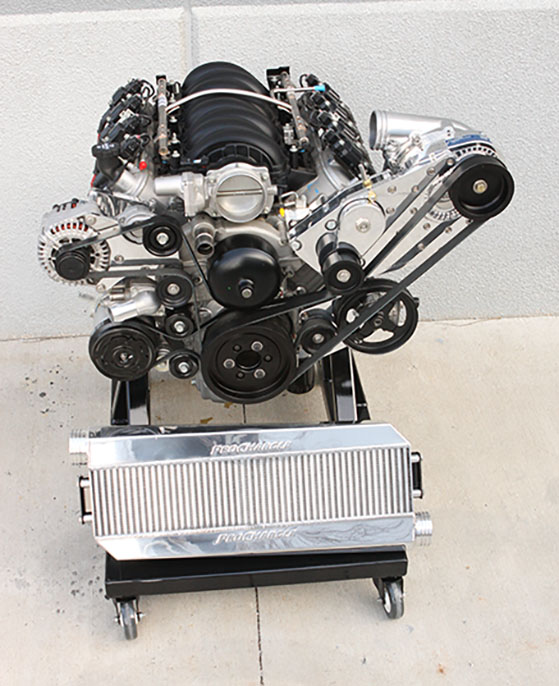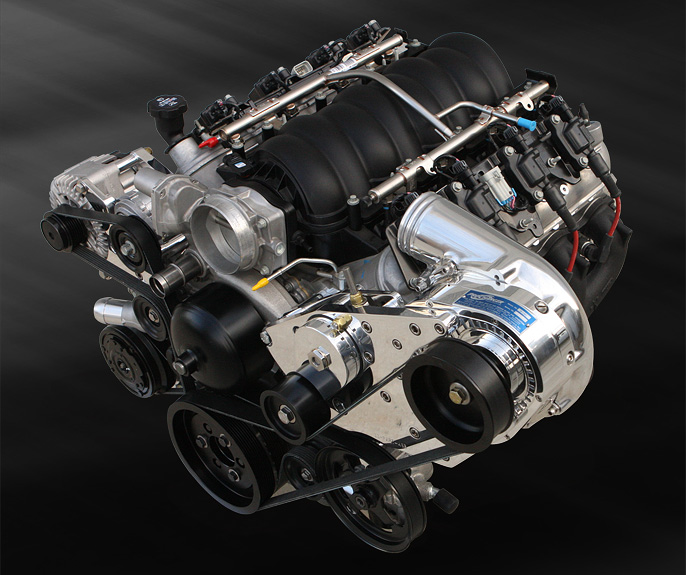LS Swap Procharger D-1SC Intercooled
LS Swap Procharger D-1SC Intercooled
Share on Social Media
Original Price: $5,900.00
Featuring a patented and proven self-contained ProCharger supercharger, a rigid serpentine-drive billet aluminum bracket, available air-to-air intercoolers and the ability to retain many stock accessories including air-conditioning and power-steering, the ProCharger LS Engine Swap Serpentine Drive Kit is exactly what your LS transplant vehicle needs.
An intercooled system is good for a safe, fuel-efficient and street-driveable 530 HP on an otherwise stock LS. Achieve 620 HP on an otherwise stock ProCharged and intercooled LS3.
Upgrading to a D-1SC ProCharger will support up to 900 horsepower. Significantly higher power levels are possible with modified engines and a ProCharger F-Series supercharger (tuning, injectors and fuel system required).
The serpentine drive kit utilizes a dedicated 8-rib serpentine supercharger drive (12-rib upgrade available) and includes a standard 1 year warranty on the supercharger. HO Kits with P- and D-Series ProChargers include a ProFlow bypass valve while kits with an F-Series supercharger utilize a legendary ProCharger “race” bypass valve.
AIR-TO-AIR ADVANTAGE
It’s a simple fact of physics: cooler air makes more power. On street driven vehicles, air-to-air intercooling is a natural fit because it locates the intercooler at the front of the vehicle where it is exposed to a constant supply of cooling airflow. Experts agree that air-to-air inherently provides better cooling and reliability than air-to-water intercoolers for street use. Engineered with large-volume air plenums, ProCharger’s air-to-air intercoolers utilize a highly effective and extremely durable bar and plate intercooler core design that provides large surface areas for superior levels of heat dispersion.
Air-to-air intercooling is a highly effective one step process and represents a fundamental ProCharger advantage. Compressed air enters one side of the intercooler, making its way into the bar and plate core. Once in the core, the compressed air is cooled by the airflow moving through the passages or fins of the intercooler. Next, this cooler, denser air is routed into the throttle body and into the engine. ProCharger intercoolers typically feature best in class effectiveness of 70-80%.
SPECS AND COMPARISON |
P-1SC-1 |
P-1X |
D-1SC |
D-1X |
| Volute Diameter | 9.00″ | 9.00″ | 9.00″ | 9.00″ |
| Max Supercharged HP | 825 | 950 | 925 | 1,075 |
| Motor Base HP Range | 200-450 | 300-500 | 300-500 | 300-550 |
| Max Flow (CFM) | 1,200 | 1,275 | 1,400 | 1,500 |
| Max Boost (PSI) | 32 | 32 | 32 | 32 |
| Inlet Hose Diameter | 3.75″ | 3.75″ | 3.75″ | 3.75″ |
| Inducer Diameter | 3.37″ | 3.57″ | 3.37″ | 3.57″ |
| Exducer Diameter | 5.25″ | 5.56″ | 6.25″ | 6.20″ |
| Outlet Hose Diameter | 3.00″ | 3.00″ | 3.00″ | 3.00″ |
| Outlet I.D. | 2.62″ | 2.62″ | 2.62″ | 2.62″ |
| Max Impeller RPM | 65,000 | 65,000 | 62,000 | 62,000 |
| Internal Step-Up Ratio | 4.10:1 | 4.10:1 | 4.10:1 | 4.10:1 |
| Reverse Rotation Available | Yes | Yes | Yes | Yes |
| Self-Contained Oiling | Yes | Yes | Yes | Yes |
| Oil Capacity | 6 oz | 6 oz | 6 oz | 6 oz |
On the other hand, air-to-water intercooler systems use a complex arrangement of intercooler cores, hoses, fittings, a coolant pump, electrical connections and yes, a secondary air-to-air heat exchanger. In street applications, an air-to-water intercooler is in fact an air-to-water-to-air system.
With air-to-water-to-air, heat is first removed from the air by the water circulating through the intercooler. This heated water is then pumped through a radiator, and returned to a tank. The overall system performance is “watered down” because its effectiveness is a diminishing function of the individual effectiveness of each heat exchanger. For example, 65% intercooler effectiveness and 60% radiator effectiveness produce a combined effectiveness of only 49%. “Two step” cooling is, by design, inherently less effective. Typically exposed to heat soak from the engine, air-to-water-to-air intercoolers are complex, difficult to install, and less reliable than air-to-air intercooling.
Contact us Before Ordering



Leave a Reply